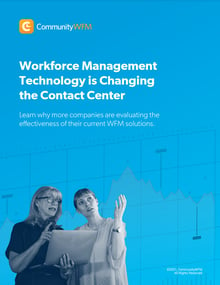
In a world where data is everywhere, practical experience can be one of the most difficult things to measure. When it comes to the contact center workforce management (WFM) industry, seeing a problem for the tenth time instead of the first can make all the difference in creating the right response that truly makes a difference.
Below are a few common WFM scheduling issues with examples of how a novice and a refined and experienced WFM analyst may approach them.
Issue #1: Getting agents to show up on time consistently for their shift is difficult
Novice Approach
Agents need rewards to show up on time. Create a program where agents receive a gift card every time they show up to work within the first 15 minutes of their shift. Monitor the clock every single time an agent is set to arrive and make a note in a spreadsheet each time an agent is on time or late for work.
Refined and Experienced Approach
Improve communication with agents by implementing a mobile WFM app. This will ensure agents always know when they are scheduled and when any shift changes may occur. Agents get frustrated if they show up to work only to find that their shift has been pushed back an hour or canceled entirely. By keeping them in the loop during the scheduling process it can help to reduce their frustration and apathy towards showing up to work on time.
Issue #2: Agents are frequently going out of adherence with unplanned breaks and absences
Novice Approach
Patrol each agent by walking around their desk or making sure they are online every hour. Manually note which agents are away from their computer at every interval and call out agents who were away multiple times throughout the day in a group email.
Refined and Experienced Approach
Connect your WFM software with your call distribution system so you can see not only when agents are working but whether or not they are on a call with a customer. At the end of the day, quickly leverage your WFM software to create a report and see which agents were out of adherence the most through the day. Monitor the situation for at least a couple weeks and meet privately with any agents that are having consistent adherence problems.
Issue #3: It’s difficult to fill shifts when schedules don’t work out as initially planned
Novice Approach
Create an agent list and provide all shift opportunities in order to the agents you think will be most likely to take them. Call or text every agent individually to gauge their interest for each shift and then modify the schedule if they agree to take the shift. Pay any and all agents overtime as needed.
Refined and Experienced Approach
Build an automatic schedule adjustment plan (ASAP) for each type of scenario within modern WFM software to be ready whenever a shift needs to be filled. When the time comes, load up and deploy the right plan to all eligible agents based on their total hours worked, skills required, and more. The request gets sent out to the mobile device of every applicable agent in a single click and is closed when an agent accepts the shift.
Issue #4: Agents continue to be unhappy with their schedules not matching their preferences
Novice Approach
Ask every single agent for their preferences each week and manually enter them into a spreadsheet. Carefully compare the spreadsheet against the staffing needs of the contact center. Build out a schedule and hope everyone is happy, even if you were unable to meet all the preferences of every agent.
Refined and Experienced Approach
Provide agents with the opportunity to bid on the schedules they want each week through shift bidding. Packages of shifts can be built within a WFM software solution for agents to bid on. There can even be multiple bidding rounds and the process can also be configured so the highest performing agents are the first employees to bid. This strategy incentivizes agents to do well so they can increase their chances of working when they want to.
Hopefully this comparison was helpful in outlining the different approaches for solving common WFM scheduling issues. The “Novice” ways aren’t necessarily wrong, but as you can see there are better strategies available by utilizing a combination of technology and experience to create both happier agents and customers.









